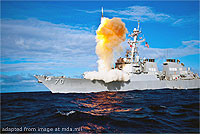U.S. seaborne missile defense endangers Russian security – expert

(Interfax – July 12, 2013) The European Phased Adaptive Approach (EPAA) stipulates reinforcing seaborne components, which will eventually develop into the backbone of the U.S. global missile defense network, consultant of the Russian Strategic Research Institute director, expert board member of the Russian presidential administration’s interdepartmental working group for liaison with NATO in missile defense Vladimir Kozin said.
“The U.S. military command and political administration believe that missile defense deployment on the World Ocean will bring significant military-strategic advantages to the U.S. Armed Forces,” Kozin wrote in his latest monograph, “U.S. Missile Defense Evolution and Russian Stance”.
In the opinion of Kozin, seaborne missile defense units “may be assigned to prepositioning missions”: either rapidly moved to conflict zones or prepositioned in the areas of anticipated conflicts.”
According to the U.S. Congressional Research Service, the U.S. Navy had 29 ships carrying Aegis Ballistic Missile Defense Systems (Aegis BMD) and various types of interceptor missiles, among them five Ticonderoga class cruisers (starting from CG-47) and 24 Arleigh Burke class destroyers (starting from DDG-51), as of April 2013.
Thirteen ships are stationed on the Atlantic coast and 16 at Pacific bases (the correlation was 11 to 18 in 2012), the monograph said.
The U.S. will have 43 cruisers and destroyers of the kind by 2022, when the EPAA plan is accomplished. Their number will continue to grow.
A long-term development program of the U.S. Navy (for the period from 2011 through 2041) says 84 ships will be equipped with Aegis BMD, including 22 cruisers and practically all (62) destroyers.
